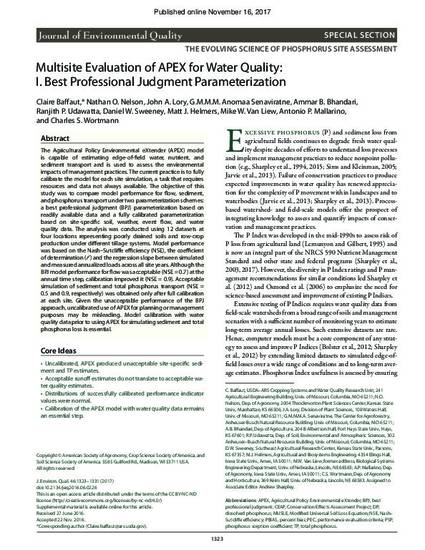
The Agricultural Policy Environmental eXtender (APEX) model is capable of estimating edge-of-field water, nutrient, and sediment transport and is used to assess the environmental impacts of management practices. The current practice is to fully calibrate the model for each site simulation, a task that requires resources and data not always available. The objective of this study was to compare model performance for flow, sediment, and phosphorus transport under two parameterization schemes: a best professional judgment (BPJ) parameterization based on readily available data and a fully calibrated parameterization based on site-specific soil, weather, event flow, and water quality data. The analysis was conducted using 12 datasets at four locations representing poorly drained soils and row-crop production under different tillage systems. Model performance was based on the Nash–Sutcliffe efficiency (NSE), the coefficient of determination (r2) and the regression slope between simulated and measured annualized loads across all site years. Although the BPJ model performance for flow was acceptable (NSE = 0.7) at the annual time step, calibration improved it (NSE = 0.9). Acceptable simulation of sediment and total phosphorus transport (NSE = 0.5 and 0.9, respectively) was obtained only after full calibration at each site. Given the unacceptable performance of the BPJ approach, uncalibrated use of APEX for planning or management purposes may be misleading. Model calibration with water quality data prior to using APEX for simulating sediment and total phosphorus loss is essential.
Available at: http://works.bepress.com/matthew_helmers/188/

This article is published as Baffaut, Claire, Nathan O. Nelson, John A. Lory, G. M. M. M. Senaviratne, Ammar B. Bhandari, Ranjith P. Udawatta, Daniel W. Sweeney et al. "Multisite evaluation of APEX for water quality: I. Best professional judgment parameterization." Journal of Environmental Quality 46, no. 6 (2017): 1323-1331. DOI: 10.2134/jeq2016.06.0226. Posted with permission.